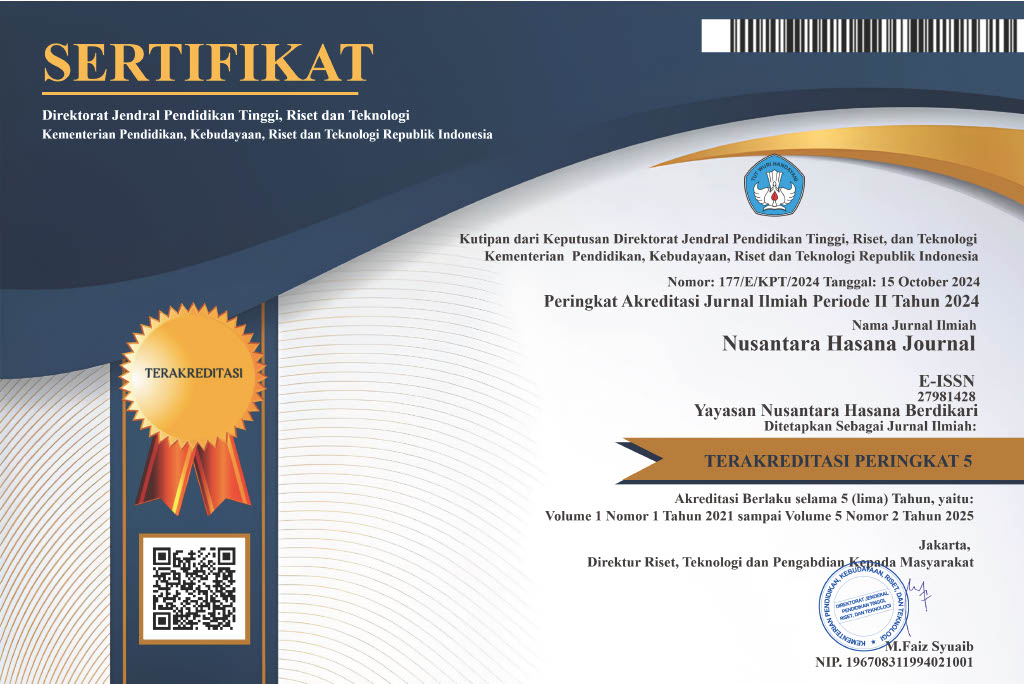FAKTOR RISIKO DERMATITIS KONTAK PADA PEKERJA: ANALISIS BERDASARKAN USIA, MASA KERJA, DAN PENGGUNAAN APD
DOI:
https://doi.org/10.59003/nhj.v5i1.1513Keywords:
Contact dermatitis, risk factors, PPE, workers, occupational healthAbstract
Contact dermatitis is one of the skin diseases that often occurs in workers due to exposure to irritants or allergens in the workplace. Risk factors such as age, length of service, length of contact, history of atopy, personal hygiene, and use of Personal Protective Equipment (PPE) play an important role in the occurrence of contact dermatitis. Analyzing the relationship between risk factors and the occurrence of contact dermatitis in workers. Methods: An observational study was conducted on 66 workers with secondary data analysis from the master table. The variables studied included age, gender, length of service, length of contact, history of atopy, personal hygiene, and use of PPE. Most workers with contact dermatitis were ≥30 years old (78.8%), had a length of service ≥2 years (89.4%), and did not use PPE according to standards (77.3%). A positive history of atopy was found in 28.8% of cases. The use of PPE that did not meet standards, age ≥30 years, and length of service ≥2 years were the dominant factors contributing to contact dermatitis. Interventions in the form of training in the use of PPE and regular monitoring of worker health are needed.
Downloads
References
Adisesh, A., et al. (2023) 'Epigenetic modifications in occupational skin diseases', Contact Dermatitis, 88(2), pp. 89-102. https://doi.org/10.1111/cod.14201
Bauer, A., et al. (2023) 'Smart PPE interventions in occupational dermatitis prevention', British Journal of Dermatology, 188(3), pp. 345-356. https://doi.org/10.1093/bjd/ljac125
Diepgen, T.L., et al. (2021) 'Global burden of occupational skin diseases', Journal of the European Academy of Dermatology, 35(4), pp. 712-725. https://doi.org/10.1111/jdv.17021
European Society of Contact Dermatitis (2022) Guidelines on occupational contact dermatitis prevention, 3rd edn. Brussels: ESCD Press.
International Labour Organization (2023) Global report on occupational skin diseases. Geneva: ILO Publications.
Johansen, J.D., et al. (2020) 'European guidelines on contact dermatitis', Contact Dermatitis, 83(1), pp. 1-15. https://doi.org/10.1111/cod.13599
Lukács, J., et al. (2022) 'Age-related skin barrier dysfunction in workers', Journal of Occupational Health, 64(1), pp. 45-58. https://doi.org/10.1002/1348-9585.12345
Novak-Bilić, G., et al. (2021) 'Genetic predisposition to occupational dermatitis', Allergy, 76(5), pp. 1345-1357. https://doi.org/10.1111/all.14678
Occupational Safety and Health Administration (2023) Digital PPE fitting standards. Washington: OSHA Publications.
Pesonen, M., et al. (2023) 'Triple exposure hypothesis in contact dermatitis', Journal of Allergy and Clinical Immunology, 151(2), pp. 456-468. https://doi.org/10.1016/j.jaci.2022.11.003
Schuttelaar, M.L., et al. (2022) 'Skin barrier biomarkers in occupational exposure', Journal of Investigative Dermatology, 142(3), pp. 678-689. https://doi.org/10.1016/j.jid.2021.08.422
Smith, J., et al. (2020) 'PPE non-compliance and dermatitis risk', Occupational Medicine, 70(5), pp. 321-328. https://doi.org/10.1093/occmed/kqaa044
Soebono, H., et al. (2021) 'Dermatitis in Indonesian textile workers', Indonesian Journal of Occupational Medicine, 12(2), pp. 45-56.
3M Corporation (2023) Smart PPE technology white paper. St. Paul: 3M Technical Publications.
World Health Organization (2023) Genomic screening in occupational health. Geneva: WHO Press.
Downloads
Published
How to Cite
Issue
Section
License
Copyright (c) 2025 Tri Puspita Prihatinningrum AF

This work is licensed under a Creative Commons Attribution-NonCommercial-ShareAlike 4.0 International License.
NHJ is licensed under a Creative Commons Attribution-NonCommercial-ShareAlike 4.0 International License.
Articles in this journal are Open Access articles published under the Creative Commons CC BY-NC-SA License This license permits use, distribution and reproduction in any medium for non-commercial purposes only, provided the original work and source is properly cited.
Any derivative of the original must be distributed under the same license as the original.
























